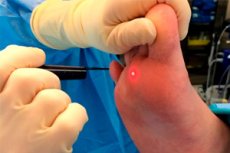Medical expert of the article
New publications
Laser blister removal
Last reviewed: 29.06.2025

All iLive content is medically reviewed or fact checked to ensure as much factual accuracy as possible.
We have strict sourcing guidelines and only link to reputable media sites, academic research institutions and, whenever possible, medically peer reviewed studies. Note that the numbers in parentheses ([1], [2], etc.) are clickable links to these studies.
If you feel that any of our content is inaccurate, out-of-date, or otherwise questionable, please select it and press Ctrl + Enter.

Calluses on the feet, toes and hands can cause significant discomfort, lead to pain when walking or performing routine and professional activities (manual work, etc.). In such cases, removal of calluses by laser may be performed.
Indications for the procedure
This method is used in the presence of old dry calluses and corns, as well as rod calluses, when it is not possible to remove them with the help of a callus patch, keratolytic ointments and creams or folk remedies.
Thus, ablative laser therapy - laser removal of dry calluses, including rod calluses - is an alternative to getting rid of them with a scalpel.
Is it possible to remove a chicken callus with a laser? It is possible. Only you should know that the callus, which has the appearance of a keratinized growth with a depression in the center and is called chicken callus, is actually a plantar wart, which is formed when infected with the human papillomavirus (HPV).
Technique of the laser blister removal
Carbon dioxide laser removal consists in layer-by-layer evaporation of keratinized tissues of the callus. The method allows you to precisely control the depth of exposure and destroy pathologically altered tissues without affecting healthy ones.
The duration of the procedure depends on the size of the callus and the depth of keratinization, so removal of rod callus by laser, i.e. Removal of ingrown calluses by laser will take longer. In the case of deep calluses laser treatment is aimed at its root or rod.
The procedure includes disinfection of the affected area and the introduction of local anesthesia, which avoids discomfort during the procedure and makes the treatment painless. The excess keratinized skin is also mechanically removed (scraped off).

